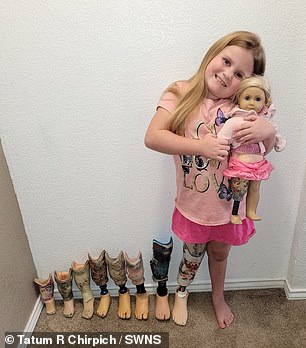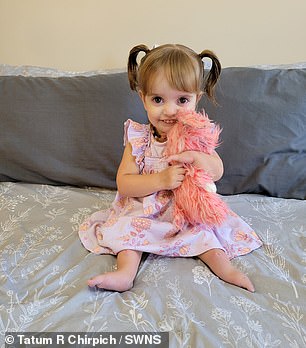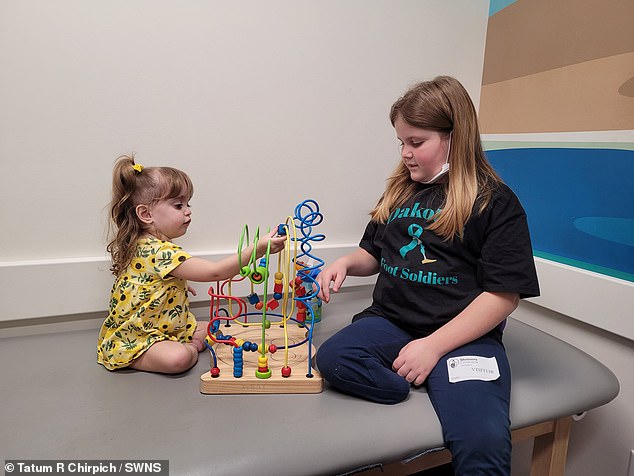Sisters, 9 and 3, both become amputees after being both born with one in 40,000 leg defects
Two sisters in Tennessee both had to undergo leg amputations after being born with a rare condition that affects only one in 40,000 children.
Tatum Chirpich’s two daughters, Kennedy and Dakota, were both born with fibular hemimelia, which meant they were each missing a bone in their legs. Kennedy had the condition in one leg, while Dakota had it in both legs.
This led to both of them having one leg that was shorter than the other.
Kennedy, now 9 years old, had her right leg amputated when she was 16 months old.
Mrs Chirpich, 41, and her husband Jeff, 47, were told the condition was not hereditary and that the chances of a second child developing it would be ‘like being struck by lightning’.
However, the parents were shocked to discover that Dakota also had the condition when she was born in 2020. When she was two years old, both legs were amputated.
Kennedy, 9, and Dakota, 3, both have fibular hemimelia, which occurs due to a genetic mutation and affects only one in 40,000 people in the world
Ms Chirpich said her daughters can do everything healthy children can do – despite common misconception, amputation is a ‘worst-case scenario’.
Instead of comparing the rarity to being struck by lightning twice, the family believes they have “won the lottery twice.”
“When Dakota was born with the condition, I was told I was being selfish for having a second child,” Ms Chirpich said. “In movies, amputation is always portrayed as an ‘end of the world’ situation.”
‘But my girls can do everything that any other child can do. They even feel sorry for me because I can’t take off my legs.’
Fibular hemimelia is a condition in which the fibula, one of the two bones in the lower leg, is partially or completely missing.


Parents Tatum and Jeff Chirpich were told that having a second child with the condition ‘would be like being struck by lightning’

Ms Chirpich said her girls’ diagnosis does not stop them from being mobile and doing most activities
The deformity usually means that one leg is shorter than the other.
It can also affect other leg, ankle and foot bones. In some cases, the foot and ankle can turn sideways if one of these bones is missing. A child’s knee and lower leg can also bend inward.
Some children may also be missing bones in their arms.
In Kennedy’s case, the condition caused one of her legs to grow to only half normal length because it was missing bones. When she was 16 months old, part of her leg was amputated and her tibia was straightened so she could get a prosthesis.
“We had to buy her a special kind of prosthetic before she was even amputated because she kept trying to walk,” Ms Chirpich said.
‘When she had just had her amputation, she continued to walk on a cast; nothing could stop her.”
In December 2022, Dakota the lower part of both her legs were amputated and her tibia bones were straightened. She is also missing the ulnar bone in her left forearm, making it slightly shorter, and she only has one finger on that arm.
“It doesn’t stop her from doing anything except counting to ten on her hands,” Ms. Chirpich said.
Fibular hemimelia is caused by a genetic error that occurs when limb buds develop in the uterus, about six to eight weeks after fertilization, according to the International Center for Limb Lengthening.
The family is one of only a few in the world known to have more than one child diagnosed.
“The term ‘losing a limb’ is so negative – I’m not saying my girls lost a limb, I’m saying they became mobile,” Ms Chirpich said. “If they had kept their limbs, they wouldn’t have the mobility that they have.”
‘I want to try to help people understand that an amputation doesn’t have to be the worst-case scenario; sometimes it’s for the best.’
